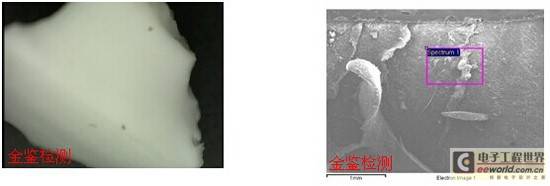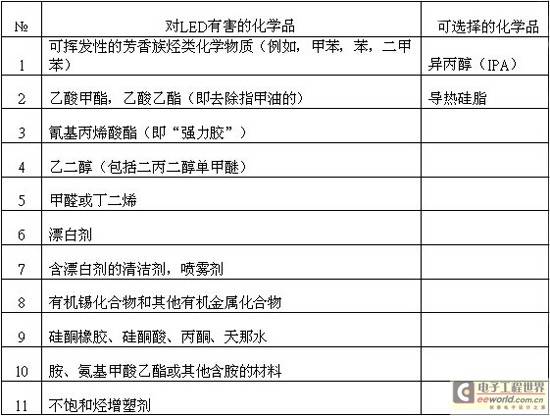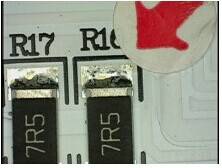There are many factors that affect the life of LED lighting fixtures. In addition to the most common poor heat dissipation, according to application experience, the reasons for LED dead light or light decay and discoloration are also caused by the pollution of chemical substances in the manufacturing process:
For downstream applications, in addition to proper heat dissipation solutions, the so-called chemical incompatibility must be avoided in the process of lamp assembly or chemical additives in the manufacturing process. Incompatible volatile organic compounds in LED lighting fixtures can quickly damage LEDs from any manufacturer. This chemical incompatibility is often a local phenomenon that occurs at elevated temperatures and in sealed lamps with little or no air flow.
After testing by LED packaging factories, some chemicals that are known to easily affect the normal function of LEDs were found. It is best for users to establish a complete chemical incompatibility test and evaluation system. With proper preventive measures, design and testing, the impact can be minimized or even eliminated.
Designers should fully consider minimizing the impact between chemical substances (mainly the primary optical lens molding glue of LED and various chemicals used in electronic assembly and lamps), because these items combined together may damage the light output efficiency of LED and even cause permanent failure of LED (such as dead light, discoloration, dim light, etc.). The result of LED failure caused by chemical incompatibility and excessive LED package temperature is the same: luminous flux attenuation and color temperature drift.
What chemicals can LEDs be used with? What types of potting glue can be used? Can potting glue be used? What effects does potting glue have on LEDs?
In the case of chemicals affecting LEDs:
1. The EDS analysis results of the bad sample LED lens are as follows:

2. The EDS factor analysis results of the bad sample LEDSilicone showed abnormal elements such as Na and Cl as shown in the following table:

Inspection of this circuit board revealed potential chemical contamination, namely a coating of a bonding lens present near the LED component (such as the lens above), which reacted chemically with the LED in a manner that was detrimental to the LED. This chemical was incompatible with the LED package itself, causing the LED to fail permanently. Therefore, it is extremely important to understand and prevent these incompatibilities between LEDs and the chemicals used in the lamp.
Silicone is a silicone material used on various high-power LEDs, such as CreeXPE LEDs. After being evenly mixed, it is injected into a mold and cured for a period of time under certain temperature conditions to form a shape. During the curing process, siloxanes do not form any fixed shape or structure. Instead, they cure into random shapes of different lengths and shapes. This produces a slightly gel-like and elastic silicone. In other words, these silicone materials are full of small holes, so silicones are breathable and moisture-permeable. Potting compound materials such as potting glue, leather rings, and gaskets that are often used in light bulbs or other solid-state lighting products will volatilize gases under the influence of elevated temperatures during assembly or processing.
Volatile gas penetration and reliability change process:
In a closed environment (like the secondary optics below or the fixture cover), any type of VOC will surround and diffuse into the LED with the porous silicone encapsulation . VOCs inside the silicone will occupy the voids within the intertwining siloxane chains. Along with the heat and high-energy photons emitted by the LED, the VOCs will discolor and block the light emitted by the LED. This discoloration usually occurs at the surface just above the LED chip because this is where the temperature and flux density are highest.
The following figure shows that VOCs change color in the gaps occupied by silicon as heat and photon energy act on them:

Silicone chain
General rules of reliability failure phenomena:
1. Accompanied by the change of luminous color and the attenuation of luminous flux, or even dead light;
2. Depending on the properties of the VOC (for example, the size of the molecule or its sensitivity to heat), this reliability failure can occur within a few hours or a few weeks.
3. LED products that experience this kind of reliability failure are generally blue light LEDs or white light LEDs that use blue light chips and phosphor packaging.
4. Red, amber or green LEDs rarely or never occur because these colors of light are low-energy wavelengths and therefore take longer to react.
Adverse effects of potting glue on LEDs:
As shown in the figure above, the discoloration of the encapsulant above the LED chip is due to a volatile organic compound releasing a dark-colored gas and diffusing from the outside into the interior of the organosiloxane-encapsulated LED component.
In most cases, these volatiles that penetrate into the gaps between the silicone encapsulant molecules will not damage the function of the polysiloxane itself. In this case, if the light and sealing cover on the discolored LED are removed and aging is continued, the gas diffused into the LED will evaporate again and may return to its original state. This is why many LEDs that are not tested in a sealed environment rarely or almost never experience similar discoloration.
However, lamp designers should pay special attention to the fact that a considerable number of volatile organic compounds (not only colored ones, but mostly colorless gases) can destroy the encapsulation glue, causing it to expand and crack, which the LED cannot withstand. The expansion and cracking of the encapsulation glue will tear off the gold wire inside the package, causing flickering, dead lights and other adverse phenomena.
Chemical selection considerations:
When selecting materials for lamps, special consideration should be given to potting compounds, adhesives, thermal pastes, fluxes and residual chemicals. Any chemicals that may come into contact with LEDs must be carefully considered. Even circuit boards will release gases that may damage LEDs as the operating temperature rises.
Therefore, pre-production testing can help prevent unexpected problems from occurring.
After experimental testing, it was found that the following chemicals are harmful to LEDs. In LED lamps, even a small amount of these chemical gases may cause the LED to discolor or damage:

Through experiments, it is found that the potting glue currently used in the market is more or less likely to contain some substances that chemically react with the LED package body or contain chemical substances that affect the sealing structure of the package.
From the EDS elemental analysis, we found that the sulfur (S) element appeared in the blackened part of the silver layer, while there was no sulfur (S) element in the normal part of the silver layer. Therefore, this type of silver discoloration belongs to sulfidation, and the sulfur (S) element is the culprit of this type of silver discoloration.
The source of factors causing LED silver discoloration:
By testing defective samples and good products with silver discoloration of LEDs, we found that silver discoloration of LEDs often occurs at the user end.
The detected cases are as follows:
Defective MCPCB detection case:
1. After scraping off the white solder mask on the MCPCB, detect the element composition of the MCPCB copper foil. The element EDS analysis component ratio is as follows:

From the above test data, it can be concluded that after scraping off the white oil on the surface of the MCPCB board, the sulfur (S) content of the copper foil is detected to be obvious, and the sulfur (S) content at different test points is also different.
2. The pads on the MCPCB circuit board are tested, and the EDS analysis is as follows. The following is the ratio of elements contained in the test results of the pads:


Pad area inspection
Through the EDS analysis of the user-side MCPCB board, the copper foil (scrape off the outer white oil) and the pad area were tested, and it was found that the sulfur content at the location where the white oil board and the copper layer are connected is very high, up to about 1.58%-3.27%, and the sulfur content in the pad area is as high as 3.55%, while the clean copper foil layer has no sulfur component. This shows that the sulfur in the MCPCB board penetrated into the LED and a sulfurization reaction occurred. Due to the difference in sulfur content in different parts, the severity of sulfurization is not consistent.
The above is just one of the materials used. In fact, some of the materials used are incompatible with LEDs. However, due to defects in the evaluation during the design, incompatibility with LEDs occurred, resulting in silver discoloration, and finally color temperature drift and decreased luminous flux.
Matters needing attention in LED application:
Based on the above reaction principles and analysis, the following matters needing attention in LED applications are listed:
1. The workshop environment should be kept below 30 degrees Celsius and within the range of 40%RH-60%RH (a thermometer and hygrometer can be used to monitor environmental changes). When touching the LED for inspection, gloves or finger cots should be worn. The packaging bag should be sealed in time after opening to prevent oxidation of the pins.
2. Avoid exposing LEDs to acidic (PH<7) workshop environments. For other purchased LED assembly materials, you can ask the manufacturer to provide the MSDS report (Material Safety Data Sheet) of the raw materials to confirm whether they contain sulfur (such as MCPCB boards, rubber gloves, rubber bands, and sulfur soaps all contain sulfur) or halogen substances (such as glass glue and low-end two-component resin glue) to prevent them from chemically or physically reacting with LED materials. For example, if LEDs come into contact with sulfur- or halogen-containing substances or are stored in an acidic environment, it is very easy to cause corrosion of the silver plating layer of LED products, and variations in the performance of LED silicone and fluorescent materials, thereby causing failure of the LED photoelectric performance.
3. The user side must pay special attention to the protective treatment of sulfur during the production process, and select MCPCB boards, solder pastes and other supporting auxiliary materials with quality assurance (free of sulfur, halogen, etc. or with content below safety standards). From the EDS analysis of MCPCB boards in several cases in the past, many boards produced on the market have different levels of residual sulfur. Although MCPCB manufacturers will clean the boards during the process to eliminate the residues of sulfur-containing and acid-containing chemical solvents, it is difficult to completely eliminate them in ordinary production processes. For this reason, it is necessary to control the quality of the residual sulfur content of MCPCB boards. Generally, the sulfur (S) content on the MCPCB copper foil does not exceed 0.5% as the upper limit standard.
4. When LED is being mounted (SMT), the following temporary measures can be used for prevention:
The characteristics of sulfur are more active at high temperatures. Before surface mounting, the MCPCB board can be put through a high-temperature reflow oven (about 230 degrees) and then cleaned (medical alcohol, etc.) (if conditions do not permit, the MCPCB surface can be cleaned directly before mounting) to reduce the sulfur content in the MCPCB pads and surface.
定期清洁回流焊炉和除湿用的烤箱减少硫或卤素的含量;控制LED或含LED的组件在銲接、处理和应用时的车间环境,控制硫或卤素的含量。
5. During the welding and processing of LED, please do not use auxiliary materials containing sulfur or halogen (such as rubber gloves, rubber finger cots, rubber bands, filling glue, glass glue, hot melt glue, etc.) to contact the LED.
Previous article:Temperature distribution and measurement of COB light source
Next article:How to solve the problem of full-color LED display screen flower
- Popular Resources
- Popular amplifiers
- MathWorks and NXP Collaborate to Launch Model-Based Design Toolbox for Battery Management Systems
- STMicroelectronics' advanced galvanically isolated gate driver STGAP3S provides flexible protection for IGBTs and SiC MOSFETs
- New diaphragm-free solid-state lithium battery technology is launched: the distance between the positive and negative electrodes is less than 0.000001 meters
- [“Source” Observe the Autumn Series] Application and testing of the next generation of semiconductor gallium oxide device photodetectors
- 采用自主设计封装,绝缘电阻显著提高!ROHM开发出更高电压xEV系统的SiC肖特基势垒二极管
- Will GaN replace SiC? PI's disruptive 1700V InnoMux2 is here to demonstrate
- From Isolation to the Third and a Half Generation: Understanding Naxinwei's Gate Driver IC in One Article
- The appeal of 48 V technology: importance, benefits and key factors in system-level applications
- Important breakthrough in recycling of used lithium-ion batteries
- LED chemical incompatibility test to see which chemicals LEDs can be used with
- Application of ARM9 hardware coprocessor on WinCE embedded motherboard
- What are the key points for selecting rotor flowmeter?
- LM317 high power charger circuit
- A brief analysis of Embest's application and development of embedded medical devices
- Single-phase RC protection circuit
- stm32 PVD programmable voltage monitor
- Introduction and measurement of edge trigger and level trigger of 51 single chip microcomputer
- Improved design of Linux system software shell protection technology
- What to do if the ABB robot protection device stops
- CGD and Qorvo to jointly revolutionize motor control solutions
- CGD and Qorvo to jointly revolutionize motor control solutions
- Keysight Technologies FieldFox handheld analyzer with VDI spread spectrum module to achieve millimeter wave analysis function
- Infineon's PASCO2V15 XENSIV PAS CO2 5V Sensor Now Available at Mouser for Accurate CO2 Level Measurement
- Advanced gameplay, Harting takes your PCB board connection to a new level!
- Advanced gameplay, Harting takes your PCB board connection to a new level!
- A new chapter in Great Wall Motors R&D: solid-state battery technology leads the future
- Naxin Micro provides full-scenario GaN driver IC solutions
- Interpreting Huawei’s new solid-state battery patent, will it challenge CATL in 2030?
- Are pure electric/plug-in hybrid vehicles going crazy? A Chinese company has launched the world's first -40℃ dischargeable hybrid battery that is not afraid of cold
- Live broadcast has ended | Microchip's latest SAM and PIC32 microcontroller software development platform - MPLAB Harmony V3
- [GD32E503 Review]——07.LCD Part 2: Drawing Custom Patterns
- Xiaozhi Science Popularization丨Why do instruments generally have set values and readback values?
- SensorTile.box emulates STEVAL-MKI109V3
- TI.com live broadcast: Interpretation of popular smart electronic locks, visual doorbells, smart sensors and network camera solutions
- 【TI Recommended Course】#What can universal fast charging bring?#
- Prize-giving Event | Tektronix High Precision Power Supply Test Knowledge Planet
- Post-COVID-19 Era: What important experiences and gains should we have? Check out these ten!
- BMA400 triaxial accelerometer development
- Principle of Sense Amplifier in SRAM

 LTC1041CS8#TRPBF
LTC1041CS8#TRPBF
















 京公网安备 11010802033920号
京公网安备 11010802033920号